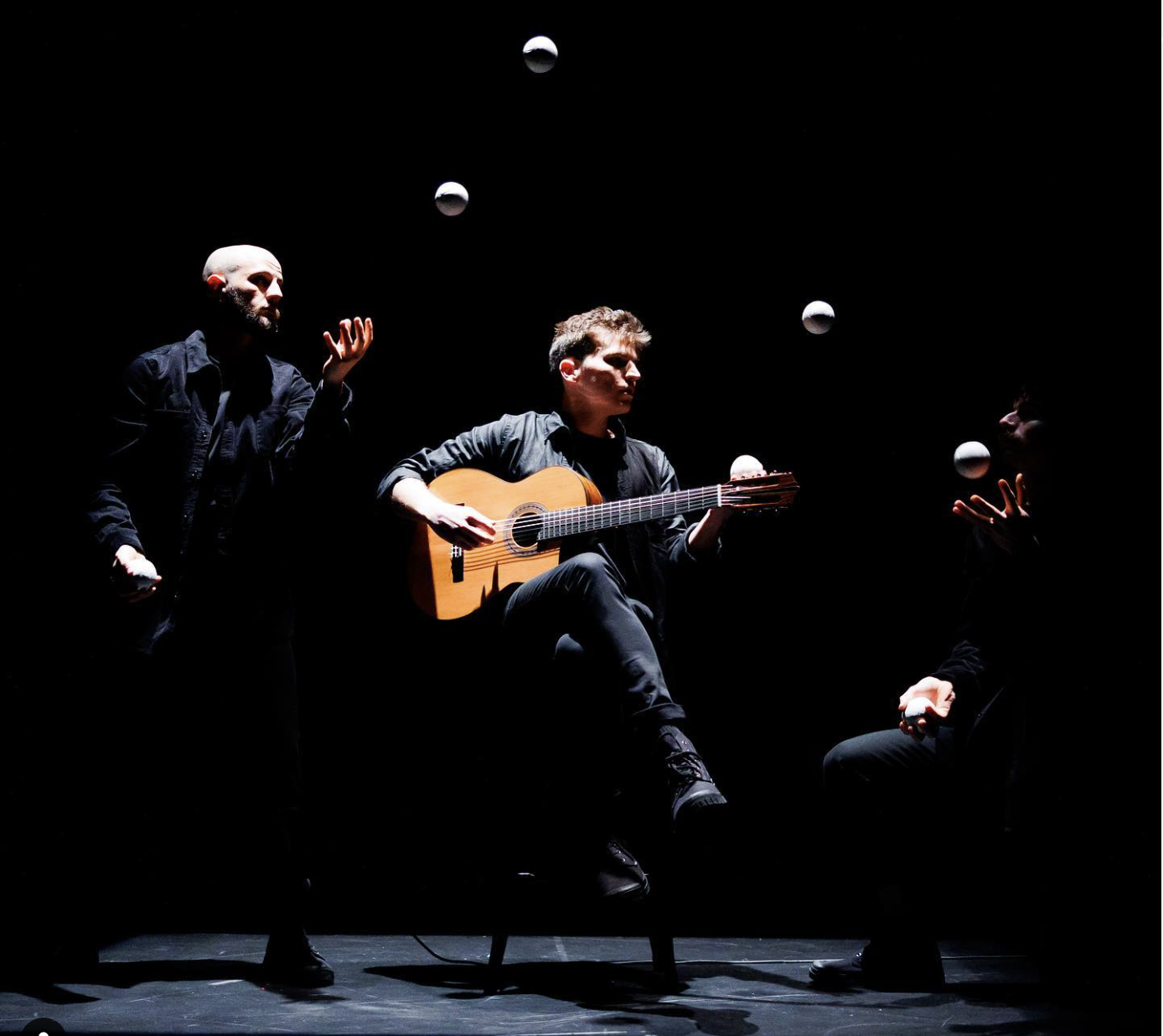Review from: Underbelly George Square, Edinburgh Festival Fringe; 27th August 2023
Which came first, the music or the juggling? The mathematics or the rhythm? Escalate is an exceptional composition of juggling sounds and sonic patterns that is so so clever, but also beautiful, and stylish, and interspersed with humour and drama conjured purely from the connections of physical and audio choreographies.
The show opens with powerful sound design that emphasises a series of simple, powerful throws and catches, creating an immediate impact. Small surprises garner entertained chuckles from the audience, which soon shift to awed ‘wow’s. Throw Catch Collective are based in Melbourne, Australia and, for all the Aussie acrobats we see in the UK, I think this is the first time I’ve seen a juggling show from down under. It’s as impressive and distinct in style from European approaches as the acrobatic fare, and I hope to see more in the future.
Escalate is a very musical performance. It’s percussive. Remember when shows like Stomp were all the rage? This is the contemporary three-man juggling version. It’s perfomed by Byron Hutton, Richard Sullivan, and Samuel Kreusler – most of the manipulation of balls, clubs and rings is done by Hutton and Sullivan, while most of the manipulation of live sound-desk and acoustic guitar is done by Kreusler. But, of course, there is some cross over. Seeing Kreusler’s ‘digital skills’ (because he uses his digits… geddit?) in relationship with those of juggling really highlight the virtuosity of musicianship as well as the musicality of juggling technique.
The escalation of the title seems to refer to an increasing complexity as the show progresses, where the number – and type – of component parts in the presentation grows as time passes. Little moments of cleverness and precision raise vocal responses from the crowd. I let out a small sigh of bliss watching six balls arc over Kreusler, sitting with his guitar between Hutton and Sullivan in a square marked by light. His hands switch deftly between strings and balls, highlighting the importance of rhythm in juggling practise as the melody never wavers. We hear this too in the percussion of throws and catches. Later, I sigh again as six white rings travel in deliciously satisfying parallel arcs. How wonderful that people make such things for us!
In the next segment, Hutton and Sullivan – club in each hand – drop to same hand, spin, tap together in perfect time, sometimes syncopated, sometimes in unison, creating their own drumming beat. Later Kreusler plays Spanish-infused guitar as the others dance with five balls through loops and links of arms, punctuated by expansive extensions of limb or airborne trajectory. These conventional juggling props have become instruments for spatial music. The modernist set design of three giant neon-rimmed black gauze squares hide pedestals for these props, sometimes lit like exhibits in an art museum.
A seated section where balls are patted rather than tossed moves into a sideways, crablike walk. These patterns have my full attention. I would say mesmerised, but it’s a more active focus than that implies. When a juggling sequence stops, but the guitar continues, we’re amusingly wrongfooted for a moment, uncertain whether to applaud or not. Throughout the show I catch Hutton raising an eyebrow or subtly smiling at individual audience reactions, and this wry human connection makes the perfection of their performance even more heightened. The few drops are dealt with efficiently and without fuss, to no detriment of the overall effect.
In a reversal of Kreusler’s usual role passing props to his juggling companions, at one point the guitar and footpedal are set up and delivered into his waiting hands by Hutton and Sullivan. Further mirroring is seen as he plays slap style and the other two slap and stroke their rings across the floor. I’m particularly taken by the whirring sound of a spinning ring landing vertically into the space of another held horizontally.
In a UV lit section of ring toss against a recorded percussion track, the sudden diegetic silence of passes becomes a feature. Light and colour are used simply and sparingly to maximum effect. The sound-desk is used to adjust volume based on Sullivan’s proximity to a green ring placed in a square of light on the floor as he moves towards and away from and around it. We see a helicopter moment. A fireworks moment. Long balls hurled with the power of a tennis volley. The repertoire of sounds added to the live mix includes guitar, machines, and some childishly amusing ones for good measure. When catching a white ball elicits a piano note, a yellow one signals a horn and a pink one becomes a violin.
The inherent connection between the patterns of sound and visual creates a cohesion to Escalate that connects all these segments of idea into a smoothly flowing hour of exquisite skill. For me, this is perfection. It seems fitting that, as we applaud the human performers, their props on the now lit plinths receive the ovation too.
Composer: Samuel Kreusler
Lighting Designer: Nick Moloney
Production Designer: Mason Browne
Mentor: Sean Gandini
Juggling Director: Joe Fisher
Producer: Lauren Eisinger



